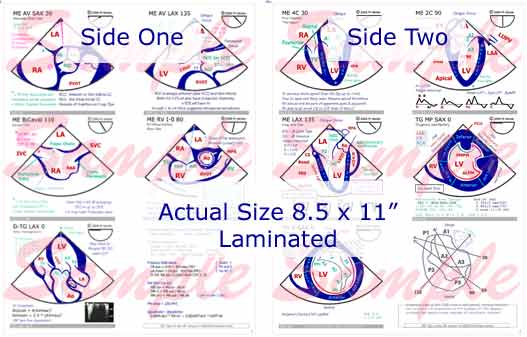|
The TEE Card™
Quick reference for structures, velocity patterns, and useful TEE equations for Intensive Care, Operating and Emergency Room use.
The TEE Card has the views you need in these fast changing, error intolerant environments. The focus is on putting into your hands the essential views for a "Rapid Recon Exam."
It gives you the information you need to decide what wall is not working, which leaflet is blown, and
to help your sort out just what is that weird thing in the right atrium ...
Special Rebate
Plus Free Shipping
< Click Here >
Individual Practitioner Only
|
|

Heavy Duty Laminated TEE Quick Reference Card

Click For Detail View
|
|
... On the other hand, there is also enough information to help you sort out if your patient has pseudonormalized diastolic dysfunction, a restrictive filling pattern, or mild LVH amongst other common abnormalities.
The views on The TEE Card are ME: AV SAX, AV LAX, 4C, 2C, LAX, BiCaval, RV IO; TG: B SAX, MP SAX; and DTG.
These were selected to show the distributions of the major coronary arteries, all the walls of the LV, a complete look at the AV, a good look at the MV, TV, RV, and Ascending Aorta, and to allow for evaluation of both atria.
Also found on the card are transmitral and pulmonary vein velocity flow profiles - both normal and with the four classic stages of Diastolic Dysfunction. Normal valve areas are also given, as well as tables showing aortic root measurements.
Formulae are given for some of the more reproducible and useful estimations of valvular area and intracardiac pressures, but, as such echo determinations can be very time consuming, only those that can be rapidly performed are included. A somewhat more extensive listing of hemodynamic calculations can be found on our T-20 Card Card: But, again, formulae are not the focus of that reference card either.
There is also a graphic showing the approximate cuts through the Mitral Valve of the various standard MV Views. Remember, which scallops are actually imaged in any given patient, in any given view are much more variable than one would suspect from reading the various echo texts.
And, yes, there is even more!
The TEE Card is a concise tool for directing you to the most essential parts of a TEE exam in an unstable patient. However, if you are looking for a handy reference sheet to the comprehensive Intraoperative TEE Exam - as jointly established by the American Society of Echocardiography and the Society of Cardiovascular Anesthesiologists - then take a look at our TEE-20 Card.
|


